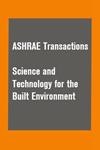Automated Fault Detection and Diagnosis of Airflow and Refrigerant Charge Faults in Residential HVAC systems using IoT-Enabled Measurements
IF 1.7
4区 工程技术
Q3 CONSTRUCTION & BUILDING TECHNOLOGY
Science and Technology for the Built Environment
Pub Date : 2023-07-10
DOI:10.1080/23744731.2023.2234231
引用次数: 0
Abstract
While automated fault detection and diagnosis (AFDD) in residential heating, ventilation, and air-conditioning (HVAC) using smart thermostat data is gaining increasing attention in recent times, it still requires in-depth investigation for market adoption, especially with real-life data. This paper proposes an Internet of Things (IoT) - based approach that adds a smart sensor to the smart thermostat data to carry out AFDD. The approach uses a model which predicts enthalpy change across the evaporator and compares the prediction to the measured enthalpy change. Deviations which exceed analytically determined thresholds then signal faults in the HVAC system. The faults detected are either installation related or degradation related. Experimental tests were carried out in four homes located in Norman, Oklahoma. From the tests, installation issues like indoor/outdoor mismatch were detected in two homes, while a 30% low charge and low indoor airflow rate were detected in one home. The results show that the proposed AFDD algorithm was able to successfully detect two prevalent faults, namely low indoor airflow and low refrigerant charge. Unlike most of the smart thermostat-based approaches, the proposed IoT-based approach can detect and diagnose both faults but only require one additional sensor which is provided by smart thermostat manufacturers.使用物联网测量对住宅暖通空调系统中的气流和制冷剂充注故障进行自动故障检测和诊断
本文章由计算机程序翻译,如有差异,请以英文原文为准。
求助全文
约1分钟内获得全文
求助全文
来源期刊

Science and Technology for the Built Environment
THERMODYNAMICSCONSTRUCTION & BUILDING TECH-CONSTRUCTION & BUILDING TECHNOLOGY
CiteScore
4.30
自引率
5.30%
发文量
78
期刊介绍:
Science and Technology for the Built Environment (formerly HVAC&R Research) is ASHRAE’s archival research publication, offering comprehensive reporting of original research in science and technology related to the stationary and mobile built environment, including indoor environmental quality, thermodynamic and energy system dynamics, materials properties, refrigerants, renewable and traditional energy systems and related processes and concepts, integrated built environmental system design approaches and tools, simulation approaches and algorithms, building enclosure assemblies, and systems for minimizing and regulating space heating and cooling modes. The journal features review articles that critically assess existing literature and point out future research directions.
 求助内容:
求助内容: 应助结果提醒方式:
应助结果提醒方式:


